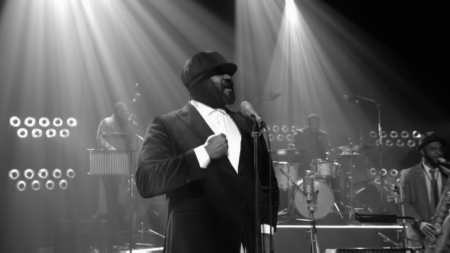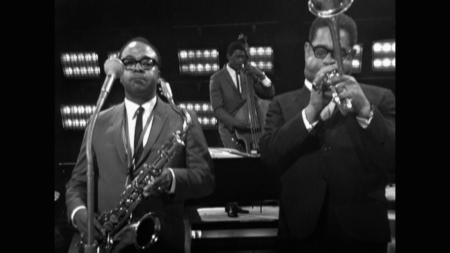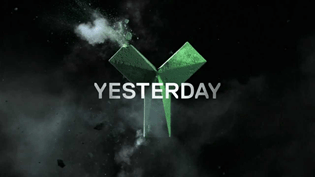The last time I’d seen Stu, we were both in tuxedos. It was a packed hotel ballroom in London, the evening Jazz 625 Live: For One Night Only (Somethin’ Else/BBC Four, 2019) won Best Music Programme at the Broadcast Awards. Weird to think of that now, rubbing elbows with tipsy celebrities. A month later, we’d be in lockdown. I’d kept in touch with him this year and sent appreciative messages about his lighting on Sing It Loud: Black and Proud (Whisper/Channel 4, 2020) and Jazz 625: The British Jazz Explosion (Somethin’ Else/BBC Four, 2020). This week, we met on Zoom in more casual attire.
Nicolas Pillai: Stu, I wanted to know how you got into the lighting game.
Stuart Pring: After university, I moved back up to Wolverhampton where I’m from and somebody said, “Oh, they need help loading in the bands playing the local polytechnic.” And then one thing led to another, I started working at bigger venues and then a band asked me to go on tour. And I ended up helping the lighting crew. I’ve always loved music and was also into sport and climbing. So doing lighting, watching guys climbing around lighting rigs, ticked all the boxes. I love travel, that was another thing. And so yeah, I went on tour with bands for years. I worked for Radiohead, did their big OK Computer world tour, Neil Young, Oasis, a bunch of bands back in the 90s, The Bee Gees. From around 2000, I didn’t want to be away from home so much so that’s how I came into TV. I worked my way up to what they call a gaffer, which is like a lighting designer’s right-hand man. They’d design it, I would make sure all the kit was there and put it up, crew it and things like that. And then I got the chance to light my own shows, and having watched others and learned the ropes I came up with my own style. And I’ve been very lucky that 95% of what I do is music: I just love the creativity that music gives you.
NP: It’s very different to the BBC model of training at Wood Norton, then being assigned to a unit.
SP: When I first started in this business, you used to get BBC line directors who always wore a shirt, tie and a suit. I remember doing things like Songs of Praise and it was all very mathematical lighting. Coming back from finishing Radiohead, and going into a Saturday night TV show I saw how the lighting technique was far behind what was happening in the tour world. A lot of it was just taking my experiences from what I’d done live into the studio, to get that energy.
NP: We first met in Cheltenham on the set of Jazz 625 Live. And there was a lot in the press about it being the first black and white show on the BBC since 1971, or whatever. How did you prepare, because presumably it was quite unlike some of the jobs you’ve done before?
SP: I think Lee-Anne [Richardson, Head of Production at Somethin’ Else] had told me it was coming up, and I got sent your book chapter to read. I did a lot of research online myself and took some ideas on how to create a set out of the lighting (it was quite a small budget). And then going black and white, I’d never done it before and I realised there’s not really many places you can go with it! I had two looks, I think: one of them was with beams and smoke, and another one was without. I went down the route of side lighting everybody, so you get those moody classic shots of rim lighting and let the cameras play to the dark side with contrasts and shadows. You must have seen the Blue Note documentary that came out about six, eight months ago? There’s a fantastic segment in that about the photography of the time and I started looking at those jazz photos. We fought for beautiful film cameras as well on it, which I use everywhere. I just insist that we use those rather than standard telly cameras, because you get so much more out of those lenses. So, it’s like, how do we play with the light? How do we get these iconic, classic photos you used to get of Dizzy [Gillespie]? Shadows and light make the pictures come alive, and lighting jazz is all about that relationship between the musicians, that playoff in which no song’s ever the same twice.
NP: What’s the first thing you do? Look at a floorplan?
SP: Yeah, so the first thing is obviously just look at a floor plan. And then I always just sort of come up with an idea – “what can we do with this one?” I’d seen a particular kind of lighting on an old 625, with these round discs of light. And I think it was used only on about two or three Jazz 625’s because they were all different, some of them just had a drape, there wasn’t a particular look to the overall shows. So I thought I’ll use a modern version of that light to make that our set [Fig. 1 and 2]. And then you just find out what kind of musicians we’ve got, and then the next thing is talking to Marcus [Viner, the director] about camera positions. I just always kind of tend to have this ping in the back of my head of what I’m going to do for a show or for an artist, you know?

Fig. 2: Gregory Porter: image by Steven Cropper. Jazz 625: For One Night Only (Somethin’ Else/BBC Four, 2019).
NP: Yeah.
SP: It’s worrying when I don’t get that ping! You know, “that’d be great to do that” – like the recent Jazz 625 had a circular stage with the track going around it, with the musicians facing in and just playing off each other. It’s all about that, make it intense, make it about that [camera] move, then I covered all the walls with lights around. I wanted the sense of not knowing where we were, semi-industrial, but modern like these guys mixing jazz with all sort of modern genres. Marcus wanted two stages, so let’s go with the round stage. And then we’ll fit one in the corner, and we’ll design this with LEDs, like infinities that return. So one is a circle and one’s like this tunnel [Fig. 3 and 4].

Fig. 3: Sarathy Korwar: image by Steven Cropper. Jazz 625: The British Jazz Explosion (Somethin’ Else/BBC Four, 2020).

Fig. 4: Ezra Collective: image by Steven Cropper. Jazz 625: The British Jazz Explosion (Somethin’ Else/BBC Four, 2020).
NP: I texted Janie Valentine [producer, Jazz 625: The British Jazz Explosion] after watching, “Where was that studio?!”
SP: (laughs) Yeah, it’s out near Purfleet, the Dartford tunnel, quite a way outside town. It was a black box studio, so you can make that what you want. The other idea I had for that show was the hanging pictures. I’d seen Fabrice’s [Bourgelle, photographer and film-maker] artwork on his website, so having some really cool, iconic art just floating in space was the idea. It gives you depth to the set.
NP: This is a really basic question: are you constantly worrying about reflections off instruments?
SP: If you get nice candy lights in the background, like we had on the first 625 or the Ronnie’s show, the reflections actually add to the pictures. On the first 625 we had the black shiny floor. In the more recent one, we just left the floor grey. But if you’d done that with all the LED strips and put the black floor in again, you’d have got all that reflected in the floor. But it wasn’t the look we were going for this time, it’s a bit too “Saturday night” and here we wanted something more gritty.
NP: I remember in Cheltenham, just before the live light went on, Lee-Anne was polishing that floor, working really hard!
SP: No shiny floor for that reason as well! (laughs)
NP: There’s a functional aspect to lighting, which is allowing viewers to see what’s happening. But then there’s also the creation of mood and atmosphere.
SP: I mean, lighting people is quite straightforward. But it’s coming up with the bigger picture, like our first 625 with the rows of lights behind. That’s what people see as the lighting, they don’t see the fact that people are lit right. It’s the “zhuzh” behind which they get drawn in by that creates a scene or a mood, a wow factor or gives it a different look. There’s certain ways to play with camera settings, which I do a lot. You just play in-camera and desaturate. For the new 625, I wanted it quite desaturated, kind of quiet. Give it that HBO/Netflix drama look that’s popular at the moment, almost greenish hue over the picture, kind of sat back. I tend to work at a really open stop. In the studio, it’s really dim. So you get more depth in your pictures by having the iris on the camera wide open, and then you just go really shallow depth of field, and that gives you all those gorgeous in- and out-of-focus bits and pieces.
NP: I’m really jealous of you because you’re the only person I’ve talked to since lockdown who’s been enjoying loads of live music. I miss going to gigs.
SP: Yeah, I’ve seen plenty of bands! But I’ve done a few live streams and it really proves the importance of audiences. People just take it for granted but it’s dead without an audience in so many ways. When there’s no feedback, none of that emotion from the audience.
NP: One of the things I kept seeing in people’s response on social media to the new 625 was “I’ve missed this!” so one of the things the show was doing, I think, was giving people back that enjoyment they’ve been lacking.
SP: But you know what? In normal times, we would never ever have had those eight acts in the studio on the same night, because they would not have been available. You know, they’d have been on world tours, they’d have been busy in studio sessions, they’d have been doing something. I do a lot of music shows, and it’s been a nightmare trying to get five acts in over five days: other commitments come along, they can’t make your TV show because all of a sudden their single took off, and now they’ve got more promo work, and they’re going to stay in the States longer… To get so many acts there and then in that moment? Would never happen in normal times.
NP: Do you think you need to have a sympathy with the music to light it well?
SP: You probably do actually. I think jazz is one of my favourite genres. I’ve been following it [the London jazz scene] for a couple of years and I’ve been trying to get it on TV for a while. I’ve been banging on to Lee-Anne, I even spoke to the people at BBC Introducing. I was like, “You’ve got to get these acts on, they are nailing it. It’s the new thing.” And I’ve been going to the gigs for a couple of years, I’ve seen quite a few of these bands around town. I saw Sons of Kemet about a year ago at KOKO [Camden music venue]. It was incredible, one of the best gigs I’ve ever been to, the place was absolutely packed with all age groups, every genre, people from all over the world, just having the time of their life. It was such an amazing gig, so full on, everyone’s dancing away. It was brilliant, such a great atmosphere. Hopefully a lifetime of music will come off these guys, you know? It’s brilliant. I love it. It’s that level of musicianship, intenseness, the relationship between the musicians. It’s capturing that somehow. With jazz, you can play with looks, you don’t have to keep flashing the lights and you can just build some beautiful things.
Dr Nicolas Pillai is a research fellow at Birmingham City University. With Dr Katherine Williams he is co-editor of Jazz Research Journal. He is currently working on the edited collection Rethinking Miles Davis for Oxford University Press.




